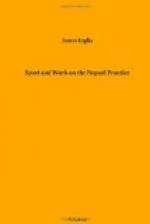The river Koosee, on the banks of which, and in the long grass plains adjacent, most of the incidents I have recorded took place, takes its rise at the base of Mount Everest, and, after draining nearly the whole of Eastern. Nepaul, emerges by a deep gorge from the hills at the north-west corner of Purneah. The stream runs with extreme velocity. It is known as a snow stream. The water is always cold, and generally of a milky colour, containing much fine white sand. No sooner does it leave its rocky bed than it tears through the flat country by numerous channels. It is subject to very sudden rises. A premonitory warning of these is generally given. The water becomes of a turbid, almost blood-like colour. Sometimes I have seen the river rise over thirty feet in twenty-four hours. The melting of the snow often makes a raging torrent, level from bank to bank, where only a few hours before a horse could have forded the stream without wetting the girths of the saddle.
In 1876 the largest channel was a swift broad stream called the Dhaus. The river is very capricious, seldom flowing for any length of time in one channel. This is owing in great measure to the amount of silt it carries with it from the hills, in its impetuous progress to the plains.
In these dry watercourses, among the sand ridges, beside the humid marshy hollows, and among the thick strips of grass jungle, tigers are always to be found. They are much less numerous now however than formerly. As a rule, there is no shelter in these water-worn, flood-ravaged tracts and sultry jungles. Occasionally a few straggling plantain trees, a clump of sickly-looking bamboos, a cluster of tall shadowless palms, marks the site of a deserted village. All else is waving grass, withered and dry. The villages, inhabited mostly by a few cowherds, boatmen, and rice-farmers are scattered at wide intervals. In the shooting season, and when the hot winds are blowing, the only shadow on the plain is that cast by the dense volumes of lurid smoke, rising in blinding clouds from the jungle fires.
According to the season, animal life fluctuates strangely. During the rains, when the river is in full flood, and much of the country submerged, most of the animals migrate to the North, buffaloes and wild pig alone keeping possession, of the higher ridges in the neighbourhood of their usual haunts.
The contrasts presented on these plains at different seasons of the year are most remarkable. In March and April they are parched up, brown, and dead; great black patches showing the track of a destroying fire, the fine brown ash from the burnt grass penetrating the eyes and nostrils, and sweeping along in eddying and blinding clouds. They then look the very picture of an untenable waste, a sea of desolation, whose limits blend in the extreme distance with the shimmering coppery horizon. In the rainy season these arid-looking wastes are covered with tall-plumed,




